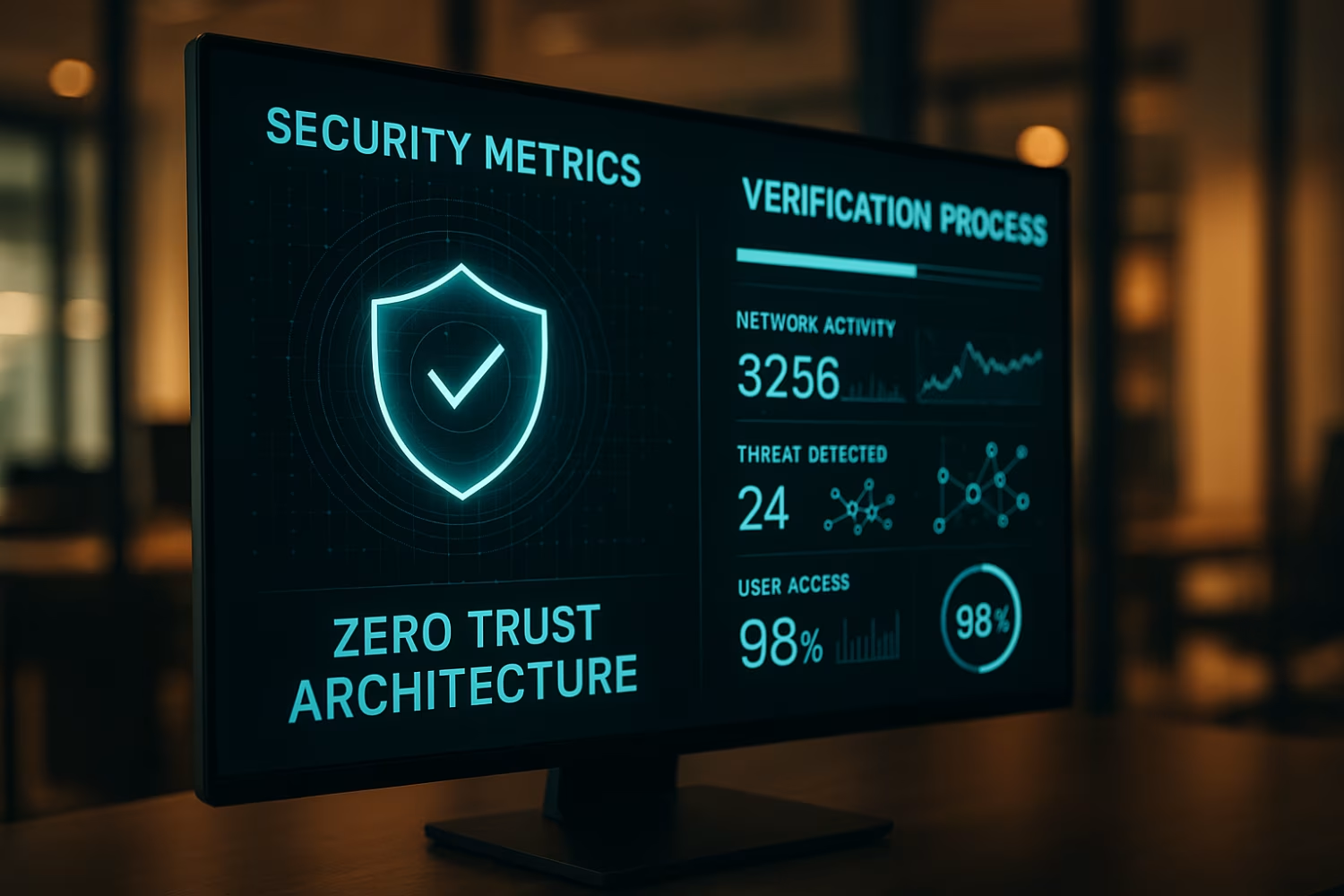Zero Trust Architecture: Benefits, Models, and How to Implement
November 11, 2025

Zero-trust architecture is no longer optional—it's a necessary shift for businesses that want to stay secure. If you're managing sensitive data, remote users, or cloud services, traditional security models just don't cut it anymore. In this blog, you'll learn what zero trust architecture is, how it works, and how to move your organization toward a more secure future. We’ll also cover the zero trust maturity model, key benefits, and practical steps to implement it.
[.c-button-wrap][.c-button-main][.c-button-icon-content]Contact Us[.c-button-icon][.c-button-icon][.c-button-icon-content][.c-button-main][.c-button-wrap]
What is zero trust architecture?
Zero-trust architecture (ZTA) is a security model that assumes no user or device should be trusted by default—even if they’re inside your network. Instead of relying on a traditional perimeter-based defense, ZTA verifies every request based on identity, context, and risk.
This model is built on the idea of "never trust, always verify." It uses access control, authentication, and continuous monitoring to reduce the risk of breaches. Whether your users are in the office or working remotely, zero trust helps protect your systems and sensitive data.
ZTA supports a wide range of environments, including cloud services, on-premises infrastructure, and hybrid setups. It’s especially useful for businesses that need to enforce strict access policies and reduce lateral movement within their networks.

Key steps to build a zero-trust architecture
To help you move forward, here are the most important steps to build a secure and effective zero-trust architecture.
Step #1: Identify your sensitive data
Start by knowing what data you need to protect. This includes customer information, financial records, and intellectual property. Once you know what’s critical, you can build your security strategy around it.
Step #2: Map your user and device access
You need to understand who is accessing your systems and from where. This includes employees, contractors, and third-party vendors. Track devices too—especially mobile and IoT devices.
Step #3: Segment your network
Divide your network into smaller zones. This limits how far a threat can spread if it gets in. Use firewalls and access controls to enforce these boundaries.
Step #4: Enforce least privilege access
Give users only the access they need to do their jobs—nothing more. This reduces the risk of accidental or intentional misuse of data.
Step #5: Use strong authentication methods
Multi-factor authentication (MFA) is a must. It adds another layer of protection by requiring more than just a password to access systems. Learn more about multi-factor authentication.
Step #6: Monitor and analyze activity
Use analytics tools to track user behavior and system activity. This helps you detect unusual patterns that could signal a breach or policy violation.
Step #7: Align with NIST guidelines
Follow the National Institute of Standards and Technology (NIST) framework for zero trust. It provides a solid foundation for planning and deployment.
Key benefits of zero-trust architecture
Zero-trust architecture offers several advantages for growing businesses:
- Reduces the risk of breaches by verifying every access request
- Improves visibility into user and device activity across your network
- Supports secure remote work and cloud adoption
- Limits lateral movement by segmenting access
- Helps meet compliance requirements with strong access controls
- Enhances your overall security posture with continuous monitoring

Understanding the zero-trust model
The zero trust model is based on three core principles: verify explicitly, use least privilege access, and assume breach. These principles guide how you design your network and manage access.
Unlike traditional security models that trust users inside the network, zero trust treats every request as a potential threat. It evaluates the context—like user identity, device health, and location—before granting access. This approach helps reduce the attack surface and keeps your systems safer.
Zero trust also supports modern IT environments, including cloud security, hybrid workforces, and mobile access. It’s a flexible model that adapts to your business needs while enforcing strong security measures.
Key components of a zero-trust platform
A complete zero-trust platform includes several tools and technologies working together. Here’s what you’ll typically need:
Component #1: Identity and access management (IAM)
IAM systems control who can access what. They verify user identities and enforce access policies across applications and systems.
Component #2: Multi-factor authentication (MFA)
MFA adds an extra layer of security by requiring users to provide two or more forms of verification before accessing resources.
Component #3: Endpoint detection and response (EDR)
EDR tools monitor devices for suspicious activity. They help detect threats early and respond quickly to minimize damage.
Component #4: Network segmentation tools
These tools divide your network into smaller zones, making it harder for attackers to move laterally if they get in.
Component #5: Security information and event management (SIEM)
SIEM systems collect and analyze data from across your network. They help you spot trends, detect anomalies, and respond to incidents.
Component #6: Policy enforcement engines
These engines apply your access rules in real time. They decide whether to allow, deny, or challenge access requests based on risk.
Component #7: Cloud security tools
As more businesses move to the cloud, tools that protect cloud services and data are essential. These include cloud access security brokers (CASBs) and secure web gateways.

How to implement zero trust in your business
Implementing zero trust takes planning, but it doesn’t have to be overwhelming. Start small by focusing on high-risk areas—like remote access or sensitive data—and expand from there.
Work with your IT team to assess your current security posture. Identify gaps in your existing systems and prioritize improvements. Use a phased approach to roll out new tools and policies, and make sure your team is trained on how to use them.
It’s also important to regularly review and update your access policies. As your business grows, your security needs will change. Stay flexible and adjust your strategy as needed.
Best practices for zero trust implementation
Follow these best practices to make your zero trust implementation more effective:
- Start with a clear understanding of your data and access needs
- Use MFA and strong identity verification for all users
- Segment your network to contain threats
- Monitor user behavior and system activity continuously
- Align with NIST and other industry standards
- Train your team on new tools and policies
- Review and update your access controls regularly
These steps will help you build a more secure and resilient IT environment.

How Sterling can help with zero-trust architecture
Are you a business with 20 to 80 employees looking to improve your cybersecurity? If you're managing remote teams, sensitive data, or cloud services, zero trust architecture can help protect your systems and reduce risk.
At Sterling, we specialize in helping growing businesses implement zero-trust strategies that fit their needs. Our team will guide you through every step—from planning and deployment to ongoing support. Ready to take control of your network security? Contact us today.
[.c-button-wrap][.c-button-main][.c-button-icon-content]Contact Us[.c-button-icon][.c-button-icon][.c-button-icon-content][.c-button-main][.c-button-wrap]-
Frequently asked questions
What is the main goal of zero-trust architecture?
The main goal of zero trust architecture is to protect your systems by verifying every access request—regardless of where it comes from. It assumes no user or device is trusted by default.
This approach helps reduce the risk of breaches by enforcing strict access controls and continuously monitoring activity. It’s especially useful for businesses using cloud services or supporting remote work.
How does zero-trust architecture differ from traditional security models?
Traditional security models rely on a strong perimeter to keep threats out. Once inside, users often have broad access. Zero-trust architecture takes a different approach.
It assumes that threats can come from inside or outside the network. That’s why it verifies every user and device, limits access, and uses analytics to detect suspicious behavior.
What are the benefits of zero trust for small businesses?
Zero trust offers several benefits for small businesses, including better protection for sensitive data and improved network visibility. It also supports secure remote access.
By implementing zero-trust strategies, small businesses can reduce their risk of cyberattacks and meet compliance requirements more easily. It’s a scalable model that grows with your needs.
What is the zero-trust model, and how does it work?
The zero trust model is a security framework that requires all users and devices to be verified before they can access resources. It’s built on the principles of least privilege and continuous monitoring.
This model helps prevent lateral movement within your network and reduces the attack surface. It’s ideal for businesses that need to protect cloud environments and remote users.
What is ZTA, and why is it important?
ZTA stands for zero-trust architecture. It’s a modern approach to cybersecurity that protects systems by verifying every access request and limiting user privileges.
ZTA is important because it addresses the limitations of traditional network security. It helps prevent breaches, supports cloud adoption, and strengthens your overall security posture.
How do I start implementing zero-trust in my company?
Start by identifying your sensitive data and mapping out who has access to it. Then, implement strong authentication methods and segment your network.
Use tools like IAM, MFA, and monitoring systems to enforce your policies. Follow the principles of zero trust and align with frameworks like NIST to guide your deployment.



